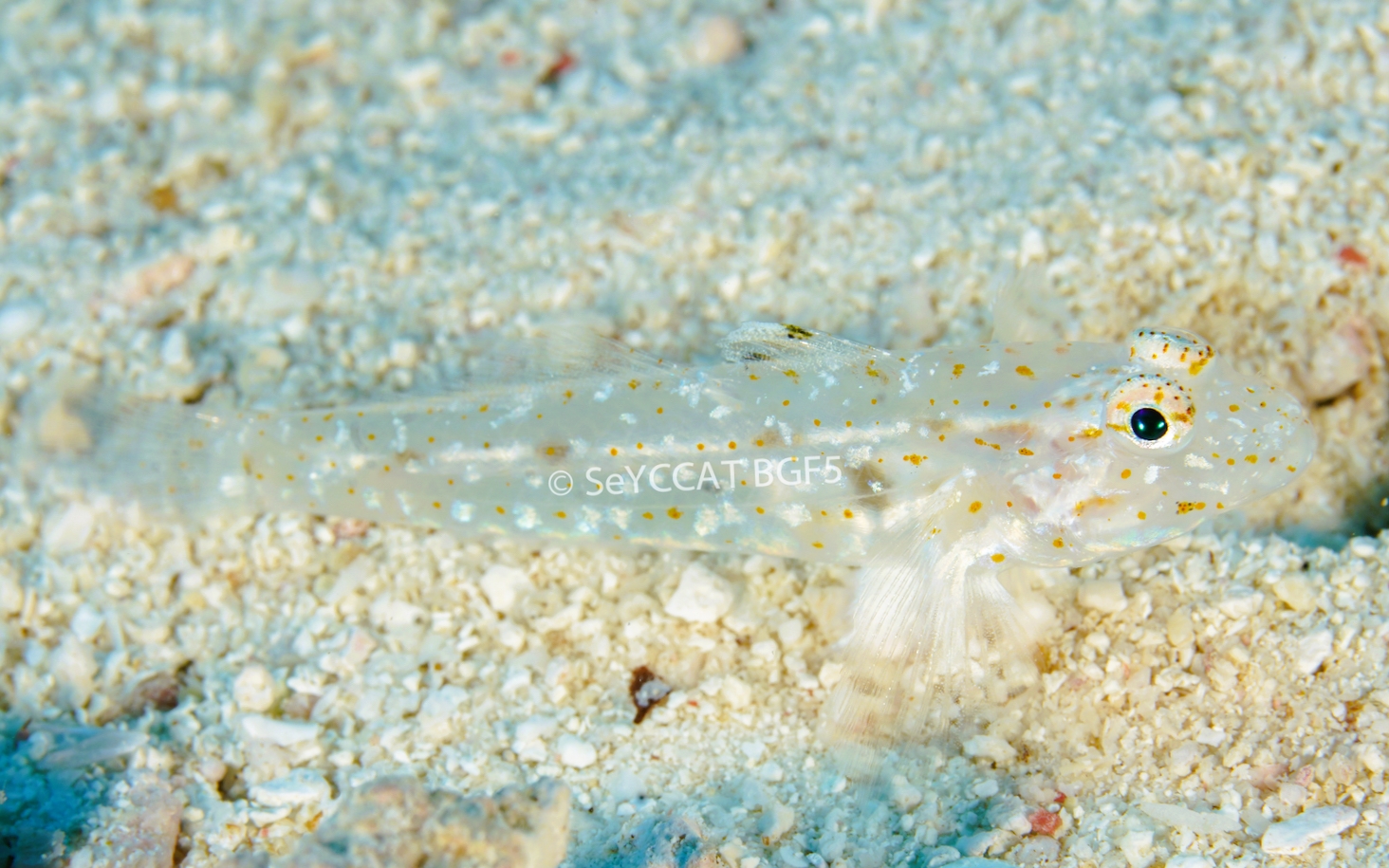Description:
Dorsal spines: 7; Dorsal rays: 9; Anal spines: 1; Anal rays: 8.
A small goby, body slender and compressed, tapering posteriorly. Head more or less triangular in cross-section. Snout short and pointed, mouth oblique.
Rear of jaws reach below front margin of pupil. Anterior nostril a short tube, just behind upper lip. Posterior nostril a pore closer to anterior nostril
than to eye. Opening of gill extending to or almost to vertical at posterior edge of opercle. Dorsal edge of eye little above dorsal profile of head.
Interorbital space very narrow and concave. First dorsal fin above pectoral fin base. First and second dorsal fins separated by a very short distance.
Pectoral fin long, extending to above second or third ray of anal fin. Pelvic fins connected to form a disc, thin membrane uniting them to or near to
tips of fifth rays. Caudal fin with a slightly rounded margin. Body covered with ctenoid scales. Prepelvic area and pectoral base covered with large
cycloid scales. Midline of nape naked. Sides of nape scaled forward to above posterior half of operculum or to above pectoral base. Cheek and operculum
without scales.
Colour. A semi-transparent greyish goby. Body with orange-brown spots and blotches. Two large black spots on first dorsal fin, anterior spot often
vertically elongate at tip of a thin black vertical line extending from base of fin, second spot between fifth and sixth dorsal spines; a faint black
spot above anterior margin of pectoral base; caudal peduncle with round to triangular spot; a thin vertical brown bar or oval blotch below eye.
Size:
Maturity: Uknown. Max length : 5.7 cm TL.
Habitat and Ecology:
Inhabits sandy floors of holes and depressions of clear seaward reefs (depth 1-46 m). Occurs singly or in groups, secretive. Benthic. Feeds on small
invertebrates.
Fishery Status:
This species is not protected or subject to fishery regulations.
Notes:
This species differs from other species of Fusigobius in pectoral ray and gill-raker counts, colouration, reduced pelvic frenum, branching of the pelvic
rays, presence of two large black spots on the first dorsal fin and shape of the first dorsal fin.
Photo courtesy Eleanor Brighton and Chris Mason-Parker (c) 2022 Blue Safari Seychelles/Marine Conservation Society, Seychelles.
Photograph taken at Alphonse group 2022.
References:
Bray, D.J. (2022). Fusigobius duospilus in Fishes of Australia, accessed 28 Nov 2023, https://fishesofaustralia.net.au/home/species/1372 (28/11/23)
Froese, R. & D. Pauly. Eds. (2023). FishBase. Fusigobius duospilus. https://fishbase.mnhn.fr/summary/Fusigobius-duospilus.html (28/11/23).
Hoese, D.F. & Reader, S. (1985). A new Gobiid fish, Fusiogobius duospilus, from the tropical Indo-Pacific. Serial Publication No. 36. J.L.B. Smith Institute of
Ichthyology. Grahamstown, South Africa. ISSN 0075-2088
Munroe, T.A. & Greenfield, D. (2016). Fusigobius duospilus. The IUCN Red List 2016: https://dx.doi.org/10.2305/IUCN.UK.2016-3.RLTS.T193160A2202464.en. (28/11/23).
Citation:
Nevill, J.E.G., Brighton, E. & Mason-Parker, C. (2023). Fusigobius duospilus, Barenape goby. Seychelles Seatizens. www.seatizens.sc. https://seatizens.sc/species/fusigobius-duospilus-hoese-reader-1985/



Fantastic post.Thanks Again. Much obliged.
Awesome article.Really thank you! Will read on…
Thanks for the article.Thanks Again. Fantastic.
Hey, thanks for the blog post. Awesome.
Enjoyed every bit of your blog.Really looking forward to read more. Will read on…
I really liked your post.Thanks Again.
Im thankful for the blog article.Much thanks again. Fantastic.
I really liked your blog.Really looking forward to read more. Fantastic.
Thanks a lot for the blog article. Really Cool.
Very good blog.Much thanks again. Want more.
Very informative post.Much thanks again. Cool.
Really enjoyed this article. Really Cool.
Enjoyed every bit of your article post.Really looking forward to read more.
wow, awesome article.Really looking forward to read more. Great.
Thanks a lot for the blog article.Really thank you!
Very good article.Much thanks again. Cool.
I appreciate you sharing this post.Much thanks again. Will read on…
I loved your blog post.Thanks Again. Really Great.
I appreciate you sharing this article post.Thanks Again. Want more.
This is one awesome article.Really thank you! Fantastic.
Thanks a lot for the blog post.Thanks Again.
Thanks for sharing, this is a fantastic blog article.Really looking forward to read more. Cool.
Great blog.Really looking forward to read more. Really Cool.
I really enjoy the blog article.Really looking forward to read more. Awesome.
Thanks for sharing, this is a fantastic article.Really thank you! Will read on…
Great, thanks for sharing this post.Really thank you! Really Cool.
I cannot thank you enough for the blog article. Really Great.
Thanks for the article.Really looking forward to read more. Much obliged.
I truly appreciate this blog article.Thanks Again. Awesome.